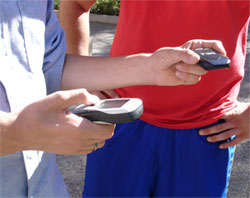Space Scientist Shares Microgravity Research
|
Irvine, Ca, March 6th, 2014 -- A NASA scientist brought space exploration down to Earth last week in an engaging presentation at Calit2. Tara Ruttley, assistant project scientist for the International Space Station, shared with a packed house some of the research occurring aboard the space station.
Following a tour of the institute’s eHealth Collaboratory and CalPlug Center, where she participated in ongoing research, Ruttley spoke passionately about the ISS. “My job is really fun and cool because I get to look at all the science happening on the space station,” she said.
About the size of a football field, the ISS was assembled in orbit over the course of 11 years. A collaboration among the U.S., Japan, Canada, Russia and several European countries, it orbits the Earth every 90 minutes or so.
Six astronauts live and work on board for six-month stints, studying material science, human physiology, life sciences, microbiology, Earth science, atmospheric science, astrobiology, astrophysics and more. “You name it – it’s done on the space station,” Ruttley said.
Because the U.S. segment of the ISS has been designated a national laboratory, the space station is available to civilians who want to send their research into space. Ruttley’s visit to UC Irvine was an attempt to explain the opportunities available to researchers and meet with potential investigators. “We want to understand what you’re doing in the field that’s cutting-edge and has never been done in space before, and see what we can do on orbit to make our lives better on Earth,” she said.
|
||||
The microgravity environment of space plays a key role in understanding a host of Earthly challenges, according to Ruttley. “At the cellular level, things change drastically in space,” she said, naming fluid distribution, gene expression, cell and signal transduction and cell locomotion for starters. These changes can have implications for many areas of human health, including tissue growth, cancer research, vaccine development, medical technology and a better understanding of disease.
For example, microbes change in microgravity, with many getting more aggressive. Ruttley mentioned salmonella, saying recent research on the space station had honed in on a protein responsible for increased virulence in this and other microbes, leading to possible advances in vaccines and other treatments on Earth.
Research on bone loss in space has led to applications for those with osteoporosis and osteopenia. Changes in astronauts’ muscles, fluid distribution, immune systems and psychological states also can be applied to problems faced by Earth-bound humans. “It’s pretty fascinating [in terms of] physiology,” Ruttley said.
Physics is another discipline where things in space are not what they are on Earth. The lack of gravity means there is no convection, leading to dramatically different heat-transfer properties. Liquids boil differently and fires burn differently, discoveries that could lead to cleaner fuels and more efficient engines.
Materials research in space has led to discoveries of new paints and finishes that can survive harsh environments, as well as stronger and more durable materials for space vehicles themselves.
“The things we think we know, we don’t always know,” Ruttley said. “That’s why the space station is the coolest laboratory to work for.”
And, because the ISS orbits the Earth approximately every 90 minutes, continually taking a series of images, its astronauts often see things from space before they’re noted on Earth. “Astronauts have spotted volcanic eruptions before the USGS ever knew they were happening,” Ruttley told the audience.
Research results are catalogued into three categories: advancing basic knowledge, advancing life on Earth and advancing the future of space exploration.
Another important focus is education. The ISS's mission is to educate students at every level – from elementary to high school, college and graduate school. “Just about every experiment done on space station has some kind of educational component,” said Ruttley, adding that more than 42 million students in 44 different countries have benefited from research conducted aboard the ISS.
A complete list of research conducted on the space station can be found at: http://www.nasa.gov/stationexperiments.
After Ruttley’s presentation, three UCI professors spoke about how microgravity studies can further their research efforts. They included: Charles Limoli, professor of radiation oncology, who investigates the effects of radiation on the central nervous system; Ali Mohraz, associate professor of chemical engineering and materials science, who is examining the physics of a new class of materials called bijels, which can mix under certain circumstances and temperatures; and Alex McPherson, professor of molecular biology and biochemistry, who uses microgravity to grow purer protein crystals that can advance knowledge of disease as well as the development of new drugs.
In 2011, NASA designated the Center for the Advancement of Science in Space (CASIS) as the sole manager of the International Space Station U.S. National Laboratory. CASIS’s mission is to maximize use of the space station for research missions; its communications manager Patrick O’Neil shared tips with the audience for submitting research proposals.
Proposals can be submitted in response to RFPs, O'Neil said, as well as through an unsolicited proposal mechanism available online. The only criterion is that research must have a benefit for those on Earth. “You stand a much better chance of getting research to the International Space Station than you might think,” he concluded.

